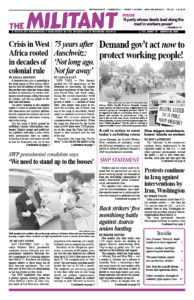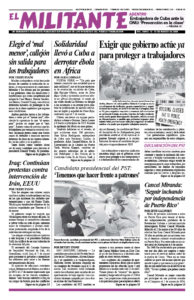After rocket attacks killed three U.S.-led coalition soldiers — two from the U.S. and one from the U.K. — at a U.S. military base in Iraq, Washington retaliated with airstrikes aimed at Tehran-backed militia forces March 12.
The Iraqi government demands Washington withdraw its military from the country. At the same time, the coronavirus began to claim lives across the country while thousands of working people and youth continue to mount protests calling for an end to foreign intervention in Iraq.
The U.S. airstrikes killed six Iraqis and were condemned as a violation of the country’s sovereignty by President Barham Salih. Iraq’s military said those slain included members of the Iraqi military, police force and a civilian, and that several members of the Tehran-backed Popular Mobilization Forces were wounded. Given the strength of Tehran’s influence in the Iraqi government, it’s hard to get the real facts.
The head of Iran’s Supreme National Security Council, Ali Shamkhani, visited Iraq March 7 to press the government to step up efforts to oust U.S. forces from the country.
Iraqi Foreign Minister Mohammed al-Hakim wrote to the U.N. March 17 attacking Washington, saying the actions of the U.S. forces “is only aiming to turn Iraq into a battlefield for regional conflicts.”
But Iraq — like Syria, Lebanon and much of the Middle East — has been a “battlefield for regional conflicts” for many years. Outside powers like Washington and Moscow, and capitalist regimes like those in Turkey, Iran and Saudi Arabia, have been fighting and maneuvering to assert their economic, political and military interests.
The Iraqi government is in the midst of a serious crisis. Divisions between supporters and opponents of closer ties with Tehran are paralyzing the country’s rulers from being able to name a new prime minister. The last prime minister resigned in the face of monthslong mass protests by workers and youth against intervention by Tehran — and Washington — demanding jobs and government services, and opposing all the regime’s hidebound political blocs.
Marine Gen. Frank McKenzie, head of U.S. Central Command, announced that Washington was responding to the missile attacks on its forces by moving ahead with the deployment of Patriot missiles in Iraq to defend the 5,000 U.S. troops stationed there. He did not get approval from the Iraqi government.
Secretary of State Mike Pompeo March 15 threatened that Washington will carry out more military attacks against Tehran-backed militias, after the Camp Taji base was subject to another round of rocket attacks, injuring U.S. and Iraqi troops.
“The Socialist Workers Party demands the immediate and unconditional withdrawal of all U.S. forces from Iraq and the removal of all other foreign troops intervening there,” Malcolm Jarrett, the SWP’s candidate for vice president, told the Militant.
“Our campaign stands in solidarity with the people of Iraq who continue to demonstrate to rid the country of its current government, as well as interference by Tehran and Washington.”
After overthrowing the Saddam Hussein regime in 2003, Washington sought to defend its interests in Iraq by occupying the country and enforcing a sectarian electoral system that continues today. It ensures the dominance of capitalist parties based among the majority Shiite population, in combination with minority Sunni and Kurdish parties.
Demonstrators demanding Tehran’s forces get out of the country are determined to continue their struggle. They’re angry at the desperate conditions they face while the Iranian rulers and their Iraqi-based militias enrich themselves by expanding control over Iraq’s oil and other resources.
So far “the death toll from the virus is much lower than the number of casualties killed by pro-Iranian militias during the last five months,” Khalil al-Assadi told al-Monitor at a protest in Baghdad in early March. In response to the beginning of the spread of coronavirus cases and deaths in Iraq, the government rapidly banned public gatherings. It has used this move to continue deadly assaults on protesters, killing three more demonstrators in Tahrir Square since March 8. Over 500 demonstrators have been killed since the protests began last October.
Rising opposition to the human and financial costs of Tehran’s intervention in bloody conflicts across the region also spurred protests throughout Iran last November and since, which were met with bloody repression.

